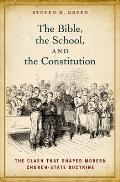The Bible, the School, and the Constitution, Redux
Paul Harvey
 Continuing on with this little series on Catholicism and its interaction with Protestantism from the colonial era to the mid/late 19th century, another review below. Several times already we've covered Steven Green's very thorough and well-researched book The Bible, the School, and the Constitution, but if you've missed those, below is a nice short review that captures some of the main points. You can also read Steven's guest post on our blog here, and David Sehat's quick appreciation (and critique) of another work by Professor Green here, and a review from the New Republic here. And hey, an excellent review from our own Chris Beneke here.
Continuing on with this little series on Catholicism and its interaction with Protestantism from the colonial era to the mid/late 19th century, another review below. Several times already we've covered Steven Green's very thorough and well-researched book The Bible, the School, and the Constitution, but if you've missed those, below is a nice short review that captures some of the main points. You can also read Steven's guest post on our blog here, and David Sehat's quick appreciation (and critique) of another work by Professor Green here, and a review from the New Republic here. And hey, an excellent review from our own Chris Beneke here.
 Continuing on with this little series on Catholicism and its interaction with Protestantism from the colonial era to the mid/late 19th century, another review below. Several times already we've covered Steven Green's very thorough and well-researched book The Bible, the School, and the Constitution, but if you've missed those, below is a nice short review that captures some of the main points. You can also read Steven's guest post on our blog here, and David Sehat's quick appreciation (and critique) of another work by Professor Green here, and a review from the New Republic here. And hey, an excellent review from our own Chris Beneke here.
Continuing on with this little series on Catholicism and its interaction with Protestantism from the colonial era to the mid/late 19th century, another review below. Several times already we've covered Steven Green's very thorough and well-researched book The Bible, the School, and the Constitution, but if you've missed those, below is a nice short review that captures some of the main points. You can also read Steven's guest post on our blog here, and David Sehat's quick appreciation (and critique) of another work by Professor Green here, and a review from the New Republic here. And hey, an excellent review from our own Chris Beneke here.| . The Bible, the school, and the Constitution: the clash that shaped modern church-state doctrine. Oxford, 2012. 294p index afp; ISBN 9780199827909, $29.95; ISBN 9780199827916 e-book, contact publisher for price. Reviewed in 2012aug CHOICE. | ||
| Although the Supreme Court only recently struck down school prayer in Engle v. Vitale (1962) and mandatory Bible readings in Abington v. Schempp (1963), legal scholar Green (Willamette Univ.) argues that the origins of these legal battles are grounded in earlier 19th-century educational battles regarding Bible reading in public schools and government funding of parochial schools. Catholics challenged nonsectarian Bible reading as Protestant oriented, and Protestants countered with no-funding legislation to sever government funding from parochial schools. Green disputes the argument that nonsectarian and no-funding policies were simple anti-Catholic posturing, contending that they drew from more principled constitutional and philosophical arguments over church and state policy that grew in sophistication throughout the century. Increasing educational secularizing trends culminated in the Blaine Amendments, which sought to amend the Constitution to prohibit states from funding public education. Although it failed to pass, several states adopted its core principles and divorced public funds from religious education. In summary, Green reminds readers that modern Supreme Court rulings were not products of sudden secularizing trends in the 20th century, but rather were grounded in a more than century-long debate over the separation of church and state. Summing Up: Highly recommended. All academic levels/libraries. -- M. S. Hill, Gordon College |

Comments
I know you had to wait for it and all but....